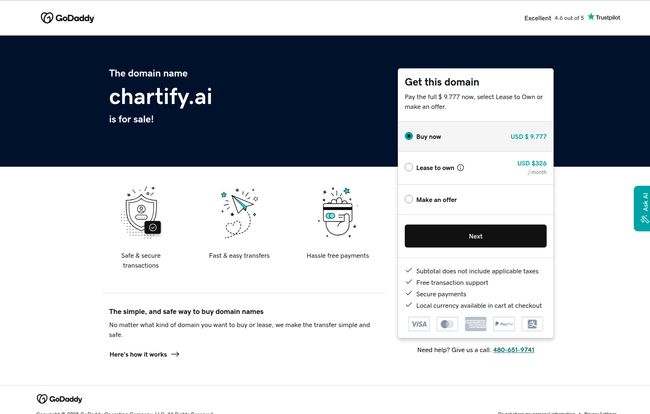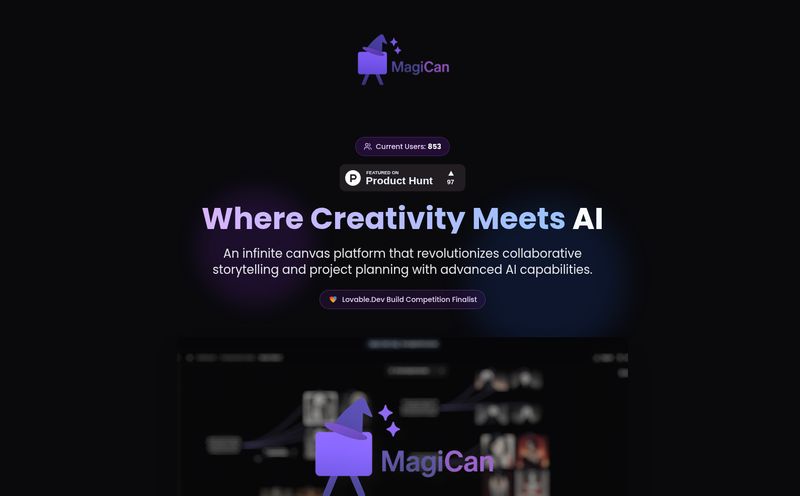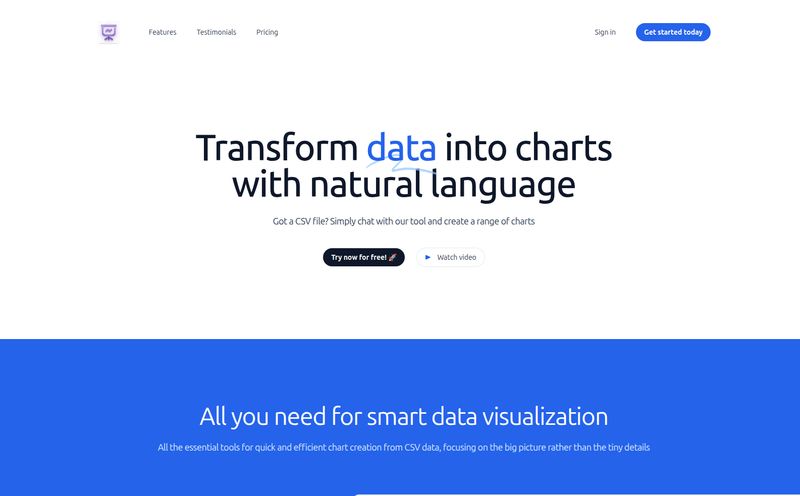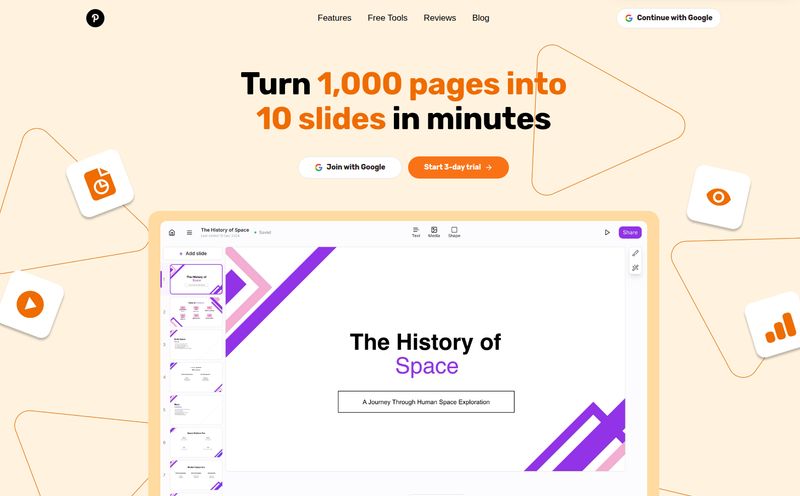You ever get that feeling you’ve stumbled upon a ghost? Not the spooky, chain-rattling kind, but a digital one. An echo of a great idea, a whisper of a tool that promised to solve all your problems, only to find… nothing. Well, that’s exactly what happened to me this week when I went looking for Chartify.ai.
As someone who lives and breathes SEO and data, I'm always on the lookout for tools that can make the slog of data visualization easier. We’ve all been there. You have a mountain of data in a CSV file, and you need to turn it into something a human can actually understand. A chart, a graph, anything! The idea of a tool that lets you just talk to your data in plain English and get a beautiful chart back? That’s the dream, right? That was the promise of Chartify.ai.
The Brilliant Idea Behind Chartify.ai
Let’s rewind a bit. Chartify.ai wasn’t just another chart-maker. Its premise was genuinely exciting. Powered by OpenAI's GPT models, it was designed to be your personal data visualization assistant. You could upload a CSV or connect a database and then, instead of fiddling with dropdowns and pivot tables, you could just ask it questions. Things like:
“Show me a pie chart of user signups by country for the last quarter.”
And boom. A chart would appear. Not only that, but it was built to be flexible, supporting popular Python libraries like Plotly, Matplotlib, and Seaborn. For the coders in the room, it would even generate the underlying code. So if the AI-generated chart was 90% there, you could just grab the code and tweak it yourself. Genius! It was solving a real pain point for marketers, analysts, and developers who hate writing plotting boilerplate code (which is, let's be honest, most of them).
It even had an AI recommendations engine to suggest visualizations you might not have thought of. This is the kind of stuff that gets data nerds like me excited. It’s about shortening the distance between raw data and genuine insight.
The Plot Twist: A For-Sale Sign on the Digital Doorfront
So, I’m all geared up to give it a spin, maybe write a glowing review. I type `chartify.ai` into my browser, hit enter, and I'm met with… a GoDaddy landing page.
The domain is for sale. For a cool $9,777.

Visit Chartify
Oof. That’s the digital equivalent of showing up to a hot new restaurant and finding a boarded-up storefront with a “For Lease” sign in the window. It’s a bit of a gut punch. An idea with so much promise, a sleek `.ai` domain, now just sitting in GoDaddy’s portfolio waiting for a buyer. You can even “Lease to Own” it for $326 a month, which feels particularly surreal.
So, What Actually Happened? Speculating on the AI Gold Rush
This isn't just a story about one failed startup; it's a cautionary tale about the current AI landscape. While we don't know the exact reasons for its disappearance, we can make some educated guesses based on the clues. And my gut tells me it’s a mix of a few classic startup pitfalls, amplified by the crazy pace of AI.
The Double-Edged Sword of API Reliance
One of the listed cons for the platform was its “Reliance on OpenAI's GPT3 model.” This is a huge one. When you build your entire product on someone else’s platform—in this case, OpenAI's API—you're essentially building a castle on rented land. What happens if they raise their API prices, making your business model unprofitable overnight? What if they release a new feature that makes your entire product redundant? It’s a risky game to play, and many founders in the initial AI boom are feeling that pressure now.
Was It a Feature, Not a Product?
This is a tough question every founder has to ask. The ability to generate charts with natural language is an amazing feature. But is it a standalone business? In the time since Chartify.ai likely launched and faded, this exact feature has been baked into much larger products. ChatGPT’s own Advanced Data Analysis can do this. Google Sheets and Microsoft Excel are rolling out increasingly sophisticated AI integrations. It’s possible Chartify.ai was simply a feature that got absorbed by the giants before it could become a sustainable product.
The Unforgiving Pace of AI Development
Let's be real, the AI space moves at a terrifying speed. A tool that was revolutionary 18 months ago might feel dated today. Keeping up requires constant innovation, significant funding, and a very, very dedicated team. Sometimes, a small team with a great idea just gets outpaced. It's not a failure of vision, but a reality of the market.
Smarter Alternatives to the Ghost of Chartify.ai
So, the dream of Chartify.ai might be on hold (unless you have ten grand to spare), but the need it aimed to fill is more real than ever. Luckily, the technology it pioneered has spread. If you’re looking for that same magic, here are a few places you can find it today:
ChatGPT (with Advanced Data Analysis): If you have a ChatGPT Plus subscription, you already have an incredibly powerful data analysis tool. You can upload CSVs, Excel files, and more, and ask it to create charts, perform statistical analysis, and even clean your data. It’s probably the closest direct successor to the Chartify.ai promise.
Microsoft Copilot (in Excel): Microsoft is embedding its Copilot AI across the entire Office suite. In Excel, it can help you identify trends, create formulas, and generate charts with natural language prompts. It's bringing the power directly into the spreadsheet software millions already use.
Google Sheets Smart Tools: Don't sleep on Google Sheets. Its 'Explore' feature has been using AI for years to automatically suggest charts and pivot tables based on your data. While not a full conversational interface, it’s surprisingly effective for quick insights.
BI Platforms like Tableau and Power BI: These heavy-hitters of the Business Intelligence world also have integrated AI features. They are more complex platforms overall, but their AI capabilities allow for sophisticated natural language querying of massive datasets.
Frequently Asked Questions about Chartify.ai
- What was Chartify.ai supposed to be?
- Chartify.ai was an AI-powered platform designed to let users create charts and graphs from data (like CSV files or databases) simply by asking questions in natural, conversational language. It supported various charting libraries and could even generate the code for the visualizations.
- Is Chartify.ai still a functioning tool?
- No, it appears the tool is no longer active. The domain name `chartify.ai` is currently listed for sale on GoDaddy, indicating the project has been abandoned.
- How much does the chartify.ai domain cost?
- As of late 2023, the domain is listed for sale for $9,777, with an option to lease-to-own for $326 per month.
- Why did a tool like Chartify.ai likely disappear?
- While we can only speculate, common reasons for AI startups like this to vanish include high operational costs (like API fees), being out-competed by larger companies that incorporated similar features into existing products, or the challenge of building a sustainable business around a single feature in a rapidly evolving market.
- What are some good alternatives to Chartify.ai for creating charts with AI?
- Excellent alternatives exist today. ChatGPT Plus with Advanced Data Analysis is a powerful option. Microsoft Copilot in Excel and the smart features in Google Sheets are also great. For more in-depth work, dedicated BI tools like Tableau have integrated AI capabilities.
A Final Thought on Digital Ghosts
The story of Chartify.ai is a fantastic reminder that in the world of tech, and especially in the whirlwind of AI, a great idea is only the first step. Execution, timing, and a solid business model are what separate the enduring platforms from the digital ghosts. It’s a bummer that Chartify.ai didn’t make it, because the idea was a good one. A really good one. But its spirit lives on in the tools we use today, and its vacant domain serves as a valuable, if expensive, lesson for everyone in the AI gold rush.



